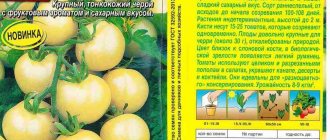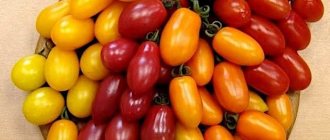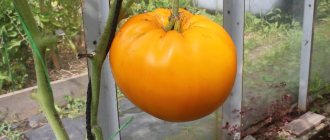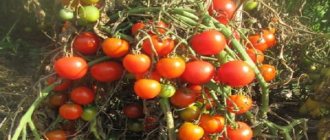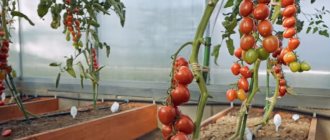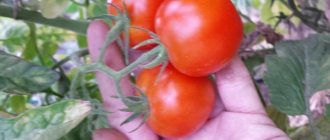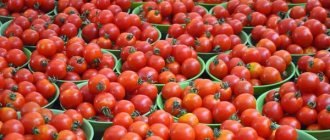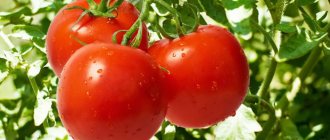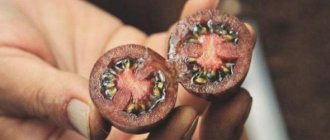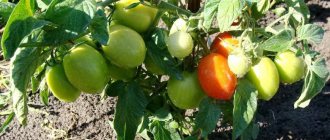Fruitful and tasty? Unpretentious and hardy? For gardeners who love to grow cherry tomatoes, the Summer an tomato will be a valuable find. Colorful, amber, glistening in the sun, the fruits have a healthy composition - they contain a lot of carotene, antioxidants and lycopene.
| Height | Landing location | Ripening time | Fruit color | Fruit size | Origin | Fruit shape |
| Tall | Greenhouse, Open ground | Mid-season | Yellow | Small | Variety | Round |
Choosing a variety according to the place of cultivation
Just buying the seeds of the most productive tomato varieties in the store does not mean that you can get a lot of tasty fruits from them no matter how you grow them. Before you give preference to one or another tomato, you need to decide where to grow it. The crop grows and bears fruit in a greenhouse and in a garden in different ways. The method of growing and caring for the plant differs.
If we take, for example, high-yielding varieties of greenhouse tomatoes and plant them in an open garden bed, they will disappoint the vegetable grower by producing a small amount of fruit. And, conversely, when productive, tasty varieties intended for open cultivation are planted in a greenhouse, the vegetable grower will receive a lot of fruits, but with a low taste index.
Advice! When choosing a tomato variety or hybrid to grow on your plot, you need to familiarize yourself with the conditions for its cultivation.
Features of the fruit
The variety belongs to high-yielding varieties. The shoots form numerous ovaries, in which a large number of tomatoes are formed. Characteristics of tomatoes:
- diameter 2.5-3 cm;
- neat round shape;
- contents from 7 to 8 fruits in a brush;
- the weight of one fruit is up to 30 grams.
Tomatoes have a bright amber color and create the effect of glowing from within. The fruits have a rich tomato taste and smell. Tomatoes are dense vegetables and have a tough skin. The pulp has a fleshy consistency; when cut, it holds its shape and does not allow the contents to spread.
Due to the high sugar content, tomatoes have a sweetish taste. When grown in a closed structure, the taste of the fruit is slightly reduced. Feedback from gardeners suggests that you should wait until the tomatoes are fully ripened to obtain vegetables with a full range of flavors.
Having an increased amount of antioxidants, tomato strengthens the body and prevents various diseases.
Diseases and the fight against them
Like any other plant, cherry tomatoes become infected with various diseases. If planting is not controlled, pathogenic bacteria will develop on the seedlings. The following are the most common diseases:
Late blight can affect most of the plant. A distinctive sign of the disease is the formation of brown spots, which are located under the upper skin of the foliage and fruits. A white, fuzzy coating forms on the underside of the affected tops. To eliminate an incipient disease, it is recommended to use a chemical antifungal fungicide. Cracking of fruits - a problem occurs when a large amount of liquid is supplied to the plant. To eliminate the disease, it is recommended to reduce the volume of introduced nutrient moisture and more often loosen the soil near the base of the tomato. Tomato mosaic - when diseased, the foliage of the plant completely changes its color. Spots of varying sizes of yellow or brown tones appear on the greenery. The foliage begins to wrinkle and curl. At the same time, the fruits are damaged - they can also acquire an abnormal dirty yellow or putrid hue. In addition to damage to the tops, the plant completely weakens. Any exposure to traditional methods or chemical fungicides does not help. To avoid infecting healthy shrubs, damaged plants are pulled out of the ground along with their roots and burned. Brown spot - occurs as brown spots on the underside of cherry tree foliage. These new growths are covered with a grayish coating on top.
The most important and correct treatment is to remove all plant debris falling from the tomatoes from under the base.
To prevent the appearance of pathogenic bacteria, the condition of the tomatoes should be constantly monitored. When the first signs appear, quick elimination of a small infection does not generally affect the bulk of the plantings. If necessary, be sure to seek help from chemical insecticides. Do not wait until the disease infects the entire area of the seedlings.
Proper care of tomatoes
Before planting Summer Sun tomato seedlings for seedlings, they should be thoroughly dried. Before planting, it is recommended to prepare in advance the planting site and soil for germinating seedlings. The soil should be fertile and saturated with micronutrients. The acidity of the soil for plants should be selected as optimal - neutral.
Features of growing tomato seedlings:
- To plant seedlings, you can purchase specialized soil in the store, or you can make it yourself. To do this, you will need to combine chernozem, river sand, peat, turf soil, rotted humus, mineral fertilizers and crushed charcoal in equal parts.
- A groove is made in the soil or small depressions are made in which the seeds are laid out.
- The top of the seedlings is sprinkled with soil in a volume of no more than 4-5 mm, slightly compacting the soil on top.
- Soil moistening must be done periodically, so that the soil is constantly moist. Seeds germinate successfully at temperatures of 24.. 30 C.
To fulfill these requirements, be sure to place the Summer Sun seedlings on a southern or southwestern windowsill so that the hatching seeds have more light and warmth. After 6-9 days, the first timid shoots will appear. After this, you should immediately move the pot with the germinating seedlings to a slightly darker and cooler (20 C) place. Watering in such conditions is carried out as needed, but until the surface dries completely.
Cherry Summer Sun does not like drought or excessive watering. Planting tomatoes occurs in the same way as planting seeds of any other plant. The only difficulty is that you should control the seeds and, when the first sprouts appear, move the flowerpot to another place so that the plants do not burn in bright sunlight.
The seedlings are placed in the prepared soil slightly deeper than they were placed previously. The seedlings, if they are stretched out, should be deepened to the very cotyledon leaves. This is necessary so that the plant produces additional lateral rhizomes, and also to make it easier for a small seedling to pick up leaves that have withered during the rooting period.
After transplantation, the plants should be placed in cool conditions that do not exceed 16 C. Be sure to place them in the sunny side, but so that during the midday heat the plants are in the shade. After this, periodic watering and loosening of the soil is carried out in order to deliver nutrient air to the roots and quickly penetrate moisture.
Such an event is planned for the last days of April - the first ten days of May. Before this process, it is recommended that the seedlings undergo a hardening procedure. To do this, you need to take the young seedlings outside for several days, leaving the plants there all day and bringing them indoors only at night.
Summer Sun cherry tomatoes are finicky plants. In order to grow healthy fruits and get a high-quality harvest, you should follow some recommendations for caring for tomatoes. The following rules are distinguished:
Tomatoes require mandatory watering; they absolutely cannot tolerate drought.
It is important to ensure daily moderate irrigation of the soil, but so that the soil is not flooded. Watering should be carried out only in the first half of the day and preferably before the first rays of the sun appear.
The introduction of nutritious moisture should be done only at the root, without affecting the tender leaves of the plant. Otherwise, the remaining moisture on the tops and the sun's rays will cause burns. The greatest amount of watering is required at the moment when the plant begins to form inflorescences and fruits. The soil should be loosened periodically, while eliminating weeds that have managed to grow. You should not provoke high air humidity - 50-60% humidity is an unfavorable condition for growth for a plant, provoking the development of pathogenic bacteria. If growing occurs in greenhouse conditions, then it is necessary to maintain a daytime temperature of 22.. 24 C, and at night it is worth reducing the degrees to 16.. 18 C. Due to the high growth of cherry tomatoes, it is recommended to constantly tie them up as they grow.
If you grow plants in a greenhouse, they will have a less pronounced taste than outdoors. Only full ripening brings Summer Sun fruits a full range of taste sensations. If you pick the fruits from the bush when they are not yet ripe, they will not have a specific aroma or unique taste.
By following simple rules for caring for tomatoes with amber-yellow Summer Sun fruits, the gardener gets an excellent harvest with excellent taste and dense inner pulp.
Landing rules
It takes up to 2 months from seeds to ripe fruits. To ensure that the final harvest does not disappoint (in relation to labor costs), follow the rules. When planting, do not damage the root system; water young plants, hill up, remove weeds, use mineral and organic fertilizers.
Preparing seeds for sowing
Buy seeds from a good manufacturer, inspect the grains, remove any missing or deformed ones. To germinate seeds, use one of two methods:
- In a container with warm water . Keep the seeds in warm water for no more than 18 hours, otherwise they will spoil due to lack of oxygen.
- In damp gauze . Dampen a cloth and wrap a few seeds in it. Keep the gauze moist, otherwise the grains will not germinate.
Sowing seeds
Plant seeds at the end of April, use disinfected soil and large containers. Prepare the furrows at a distance of 4 cm from each other, stock up on warm water. To maintain a microclimate, use transparent glass or cling film.
When the seeds have swelled and sprouted, plant them. Use your hands to avoid damaging the shell and ruining the plant. Plant the seeds to a depth of 1-1.5 cm, lightly sprinkle with soil and water. Place the container in a bright place, so the ovaries will grow faster.
Seedling care
To get a good harvest with strong seedlings, follow these care rules:
- Soil moistening. Before the seedlings appear, the plant does not need excess moisture. Strong dampness creates favorable conditions for the development of fungi. When the seedlings sprout, regular watering is needed. The fruiting rate depends on this.
- Lighting . Keep the seedlings in the light. In case of insufficient lighting, additionally install lamps as artificial light sources. Light the plant from 8 to 10 am, from 16 to 18 pm.
- Hardening . Ventilate the room where young tomatoes grow for 15 minutes twice a day. This will increase the frost resistance of adult plants and harden young shoots.
- Temperature . Maintain the temperature within 20-25 degrees, avoid exposure to drafts.
- Picking . If the seedlings are in different containers, there is no need to plant them. If planted in a common container, the first picking occurs on the 10th day after the appearance of the ovary, the second – after 1 month.
- Feeding . Organic fertilizers are needed 2-3 weeks after the first shoots appear, then weekly before transplanting into open ground.
It is recommended to use vermicompost in packaged packages as a top dressing.
More useful information about growing tomato seedlings is written here.
Transplanting seedlings into open ground
Before planting plants in the ground, make sure the soil is well warmed up. For warm areas the best period is the beginning of May, for cold areas - the end of May-June. When planting Summer Garden tomatoes under film, the optimal sowing time is the second week of April.
When the plant is 50-55 days old, transplant it into open ground. The sequence of actions is as follows:
- Prepare the soil in advance: disinfect, remove weeds, loosen and make shallow holes.
- Add a portion of humus to each hole so that young seedlings emerge faster.
- Moisten the sprouts thoroughly so as not to damage the root system when trying to remove the plant from the pot.
- Place the seedlings in the hole so that the stem goes no more than 1-2 cm deep, sprinkle with a layer of soil.
- Water the plant thoroughly.
For planting, choose a cloudy day in the afternoon. In extreme heat, do not plant Summer Garden tomatoes.
Advantages and disadvantages of the variety
Consumer demand for “cherry” tomatoes is constantly increasing every year; this fact is not surprising.
Compared to traditional varieties, miniature tomatoes have a number of advantages:
- Tomatoes bear fruit for a long time. In heated greenhouses with a durable polycarbonate or glass coating, tomatoes bear fruit until the new year.
- Cherry tomatoes have excellent shelf life and are able to retain excellent taste for a long time.
- Plants grow quickly and actively, forming into powerful bushes.
- The fruits of each variety are identical in shape and size.
- The collected fruits are well transported.
- Cherries are unpretentious to growing conditions.
Cherry tomatoes are eaten raw like regular tomatoes, as well as in the form of salads and are suitable for canning.
Disadvantages of the variety:
- Mandatory tying of all varieties, without exception.
- There are restrictions on the use of ripe fruits for people suffering from metabolic diseases.
Characteristics and advantages of the variety
Summer Sun tomatoes are cherry tomatoes.
They are planted in greenhouses to produce fruit throughout the year. The type of tomato is an indeterminate variety. Under good conditions, the plant reaches 2 meters in height. Without proper support or support, the bush cannot support its vines on its own. Therefore, it is recommended to constantly tie up the plant. Tomatoes produce a fan-shaped ovary that forms small fruits, up to 2.5-3 cm in diameter, round in shape. The maximum number of fruits in a brush reaches 7-8 pieces. Each vegetable has a small mass, not exceeding 30 grams. The color color fully corresponds to the summer name of tomato - they are represented by an amber-yellow hue. Each berry in the sun presents an invisible spectacle - as if each fruit glows with an internal special light.
In terms of taste, the plant has a unique taste and smell. The fruit is dense to the touch, the skin is strong, but it easily breaks under pressure when cut. The inner pulp is fleshy, holds its shape and does not spread. Has increased productivity. The plant has a potato leaf that releases a unique aroma when touched.
Description and agricultural technology of growing hybrid tomato Seven forty
Tomato Seven Forty belongs to the selection of Russian agrobiologists. The early ripening variety is distinguished by a long fruiting period, taste, and resistance to diseases of nightshade crops.
Advantages of a hybrid
Tomato Seven forty F1 belongs to the first generation hybrids. The variety is intended for cultivation in open ground conditions, film greenhouses. An early ripening tomato begins to bear fruit 95-100 days after germination.
During the growing season, the determinate hybrid reaches a height of 70-90 cm. The first peduncle is formed at the level of 5-7 leaves, and subsequent ones are formed at intervals of 1-2 leaves. The inflorescence is simple, 5-7 fruits ripen in the cluster.
The description of the 7/40 variety is associated with the characteristics of the fruits being round in shape. In the ripe phase, tomatoes acquire an intense red color. The stalk has no green spot. When cut horizontally, many chambers with seeds are observed.
The fruits have smooth skin, dense pulp, intense tomato aroma and taste. The fruit weight reaches 220-250 g. The crop yield is 15.5-16 kg per 1 m².
The hybrid is resistant to most diseases of nightshade crops, including Alternaria, blossom-end and root rot, and tobacco mosaic virus. In cooking, the fruits are used fresh, for preparing various dishes, and pickling.
Agrotechnical growing conditions
Tomato is cultivated using the seedling method. Seeds are planted 60 days before planting in the ground. Before sowing, the seeds are treated with an aqueous solution of aloe and a growth stimulator to ensure the smooth emergence of seedlings. The seeds are placed in a container with the prepared soil mixture to a depth of 1 cm.
After watering with warm water using a sprayer, cover the container with film until sprouts appear.
When growing seedlings, it is important to observe the temperature regime, maintaining heat at +23...+25°C. At the stage of 7-10 days of seedlings, plants are culled
Hybrid tomatoes are characterized by a purple marker color with a bronze tint (anthocyanin color). Its absence indicates that the seeds do not meet the quality indicators of current standards.
During the formation of 1-2 true leaves, diving is carried out in separate containers. For this purpose, peat pots are used, with which it is convenient to transfer formed seedlings with 1 peduncle to a permanent place.
Growing a hybrid requires compliance with the rules of agricultural technology. It is recommended to place 3 bushes per 1 m². For normal development, seedlings need access to sunlight.
The plant requires moderate watering as the topsoil dries out. You can provide drip irrigation and prevent the growth of weeds using non-woven fiber. The use of organic materials (straw, leaves) as mulch serves as a source of nutrition for tomatoes during the period of growth and fruiting.
The hybrid is responsive to the application of complex fertilizers. To ensure a balance of moisture and air near the root system, the soil is periodically loosened. Hilling up bushes stimulates the formation of additional roots, which improves plant nutrition.
The bushes grow in 1-2 stems, and the stepsons are periodically removed. Plants require tying to a support.
Opinions and recommendations of gardeners
Reviews from vegetable growers indicate the positive characteristics of the variety. The hybrid is resistant to cracking during ripening, adapts well to high temperatures, and can easily be transported over distances.
Valery Efimov, 53 years old, Voronezh.
Last season, I planted the Seven Magpie tomato in the greenhouse for the first time. I was pleased with the opportunity to pick fresh tomatoes from the bush for a long period of time. The fruits are very tasty, aromatic, with dense pulp. Excellent for canning and processing into sauce.
Margarita Antonova, 56 years old, Adler.
Seven forty tomatoes were planted in open ground. I purchased the seeds from a well-known brand. I was convinced of the quality of the material after the sprouts appeared, which had a characteristic purple hue. Before sowing, the seeds were treated with a growth stimulator. The variety pleased with its taste, high yield, fruits of the same size, with dense pulp. The description fully corresponds to the information on the packaging. The hybrid is highly resistant to diseases and biological pests.
The best varieties of cherry tomatoes 2021, according to members of the amateur tomato growers club
Adding an article to a new collection
Members of our club of amateur tomato growers shared their opinions on cherry tomato varieties. Based on their reviews, we have compiled a ranking of the best cherry tomato varieties of 2021. Who became the winner of our TOP?
By what criteria did tomato growers choose the best variety? They paid attention to taste, yield, ease of care, resistance to disease, duration of fruiting and keeping quality. Under the description of each variety, we invite you to read their reviews.
Summer Sun, or Summer Sun
The winner of our vote was a productive variety with the beautiful name Summer Sun - this is how the original name Summer Sun is translated into Russian.
The variety is indeterminate (some producers offer Summer Sun as a hybrid), the bushes reach a height of 2 m. In this regard, they require regular staking. The plant produces many stepsons, which producers recommend plucking off to form a bush of 1-2 stems. You should not plant more than 3 bushes per 1 sq.m, because they will interfere with each other.
Small - 2.5-3 cm - amber-colored fruits seem to be visible through. Due to their high sugar content, they have a very sweet taste. Despite the fact that it is considered mid-season, it bears fruit in the greenhouse until mid-autumn.
Reviews from our readers about the Summer Sun variety
Svetlana Lazareva : “Summer Sun pleased me with its taste, productivity, unpretentiousness, and long fruiting! And the taste is simply amazing! The brushes are huge and heavy.”
Barry's Crazy Cherry
In 2nd place in the TOP is a variety with a long name - Barry's crazy cherry. In the Russian translation, Barry's crazy cherry has 2 variants of the name - Barry's Crazy Cherries and Barry's Crazy Cherries. Indeterminate variety with mid-early ripening; Designed for cultivation both in greenhouses and in open ground. It is recommended to form 1-2 (maximum 3) stems.
The variety is very productive, so it requires regular garter, otherwise the clusters will break off under the weight of the fruit. The brushes have an interesting fan-shaped shape, strewn with a large number - 25 pieces or more - of sweet light yellow fruits with an elongated tip. Suitable for both fresh consumption and canning.
Reviews from our readers about the variety Crazy Barry cherries
Tanya Zhovtok : “Barry’s crazy cherry, or Barry’s Crazy Cherry - of all the ones I planted, it’s the only one with a 5+ rating: there’s a lot of it, and it’s a sane size (but not yet cocktail-type), and it’s edible, and it lasts a long time.”
Konstantin Zaitsev (Tver region): “I really liked the taste, there are fruity notes with a bias towards citrus.”
Tanya Zhovtok : “Tasty, a lot, beautiful, not very small. Let it be like a decoration for a garden and a picnic.”
Description and characteristics of the variety
Tomato San Marzano is an indeterminate medium-growing variety. The shoots grow strong and strong. Features of the bushes:
- trunk height within 1.5 m;
- 5-6 tomatoes are tied on a brush;
- 10-12 clusters are formed on the bushes.
Ripening time is average - 105-118 days from germination.
Description of fruits:
- average weight varies between 100-120 g;
- elongated shape, dimensions up to 12 cm in length;
- bright crimson color;
- the pulp is dense, moderately juicy;
- dry matter level 4-6%;
- The skin is strong and does not crack.
The taste is dominated by sweet notes, the sourness is barely noticeable.
Characteristic
This versatile variety is one of the early hybrids. For planting, use seeds or seedlings, open ground or greenhouse conditions. The fruits ripen throughout the growing season and maintain a presentable appearance during storage and transportation.
Other features of the Summer Garden variety:
- yield - up to 17 kg of fruits from 1 square area;
- ovary maturation – carpal;
- bush height – up to 60 cm;
- number of brushes – 3-4 on each bush;
- ripeness - 90-100 days after planting the seeds.
Fruit
The tomatoes are round, symmetrical, deep red in color with smooth skin. The ripe fruit weighs 120-150 g, grows in clusters of 5-8 pieces. The flesh is dense and elastic, but meaty. The fruits are multi-chambered, so they contain a lot of seeds.
When technically ripe, the tomatoes are pale, without a green spot at the stalk. When biologically ripe, tomatoes acquire a deep red or orange color, dense consistency and fleshy pulp. The Summer Garden variety is used fresh or goes for processing.
Productivity
In addition to frost resistance, an important selection criterion for vegetable growers is the high yield of the variety. During the fruiting period, you can harvest up to 3-4 kg of ripe tomatoes from one bush. From 1 square of area - up to 17 kg of tomatoes. The fruits ripen in clusters, which simplifies harvesting.
Reviews of tomatoes Summer Garden
★★★★★
Victor, 57 years old, vegetable grower, Rostov-on-Don. My Summer Garden tomatoes bear fruit all summer.
Medium-sized tomatoes, one to one, with dense skin and elastic core. We eat some fresh, the rest my wife cans. There are no problems with growing either, although I plant the bed with purchased seedlings. Once I sowed the seeds, it turned out to be some kind of hybrids. It seems to me that they slipped in defective seeds. ★★★★★
Kirill, 53 years old, farmer, Mogilev region. I love working with Summer Garden tomatoes, the main thing is not to miss planting.
With good care, the bush does not get sick and bears fruit well - up to 5 kg. We eat some of the tomatoes as a family, but more are put up for sale. The fruits are dense and transport well. If you follow the rules, they can be stored for up to a week. And this time is enough to sell the harvest. There is always a demand for this variety. ★★★★★
Vasilisa, 45 years old, agriculture, Gdansk. I have always been pleased with this variety of tomatoes, but it doesn’t happen every time.
In the last season, the Summer Garden fruits turned out to be very small, although I regularly watered and fed the bushes. There is no point in recycling it. Some were eaten at home, some were sold. This did not affect the taste, but the size clearly did not impress. Hide
Add your review
Summer Garden tomatoes are a popular variety of early-ripening tomatoes. They can grow in a greenhouse or on personal plots, and with high-quality care and watering they produce one-to-one tomatoes, tasty and dense in consistency.
0
0
Copy link
Characteristics and features of tomato
For vegetable growers, any parameters are important, from the appearance of the plant and fruit to the nuances of agricultural technology. After all, in order to get a good harvest, it is necessary to place the plant in favorable conditions. The description and photo of the Cio-Cio-San tomato will be a necessary help for gardeners.
First of all, you need to know that the amazing tomato variety Cio-Cio-San belongs to the indeterminate variety. In other words, the bush grows without stopping. The height of one plant exceeds 2 meters. This is an important characteristic of Cio-Cio-San tomatoes, which determines the nuances of caring for the plant.
You will need to install supports and tie up the tomato. Although the need for supports is dictated by one more condition - the pink tomato variety Cio-Cio-San is very productive, and up to 50 fruits of excellent quality ripen on one bush. The stems will not be able to withstand such weight without help.
The second characteristic that dictates the characteristics of care is the ripening period. Cio-Cio-San is a medium-ripening tomato. This means that the variety is grown in seedlings and the ripened fruits are harvested no earlier than 110 days after the first shoots appear.
A description of the appearance of a tomato should begin with the fruit. After all, they are the main goal of gardeners.
According to reviews, the tall bushes of the Cio-Cio-San tomato variety are decorated with clusters of elongated fruits of amazing taste. Up to 50-70 fruits can ripen simultaneously on one cluster, each weighing at least 40 grams. Therefore, one bush can provide the owner with six kilograms of tomatoes.
The tomatoes are cream shaped and pink in color. The pulp is dense, juicy, fleshy and sweet. Housewives are happy to use these tomatoes for juice. And this despite the fact that its color turns out to be pale, but the taste suits all lovers of tomato drink. Prepared fresh salads and canned tomatoes of this variety are very tasty. When pickling in jars, the fruits do not need to be cut; they fit perfectly in the container and look appetizing. And gourmets highlight the piquant taste of sauces and seasonings made from ripe tomatoes of the mid-season variety Cio-Cio-San. The only type of processing for which the variety is unsuitable is fermentation.
These wonderful fruits grow on tall bushes with an attractive appearance. Thanks to the description and photo of Cio-Cio-San tomatoes, you can see how decorative the plants look on the site. The bush is decorated with fan clusters of small oblong fruits. The bright pink color of the tomatoes goes well with the green foliage, and the shape gives the bush extraordinary attractiveness.
The height of the bush is large, the plants stand out on the ridges and in the greenhouse. They require standard actions that tall tomatoes need - gartering, shaping and pinching.
Judging by the description of the variety and reviews from summer residents, Cio-Cio-San tomatoes are characterized by good keeping quality.
Important! Ripe fruits of tomatoes of the Cio-Cio-San variety are harvested on time. If you keep them on the branches, they will crack and you will have to forget about storing them.
It is necessary to note the resistance of the Cio-Cio-San tomato to diseases and weather factors, which is extremely important for vegetable growers. The hybrid variety is almost not affected by fungal infections
It sets fruit well even during the intense summer heat, bears fruit until frost - as a result, several bushes provide fruit for the entire season. All these parameters are clearly confirmed by a video about a tomato:
Planting tomatoes in a greenhouse
Samara is planted by sowing seeds at the end of winter or with the arrival of the first spring warmth, usually in March. The seeds are placed in special containers to a depth of about 1 cm, and as soon as the young stems sprout and the first real leaves appear on them, they are planted in other containers - dived (for a good harvest, at this stage the seedlings are fed with ready-made complex compounds).
Grown seedlings are transplanted into greenhouse conditions towards the end of April, although if there is proper heating in the shelter, you can immediately sow tomatoes here. The planting pattern is usually 40x60 cm. With this growing option, the first fruits can be harvested as early as July.
Description of the tomato Rusted Heart of Everett and agricultural technology for growing the variety
Everett's rusty heart is a tomato with an exotic taste and unusual coloring. It appeared on the Russian market several years ago, although it has been known in American catalogs of garden crops since 2007.
General view of the plant
Rusted Heart is an indeterminate variety and has unlimited growth of the main stem. Over the course of a season, the height of the plant can reach 1.8-2 m. Like most heart-shaped varieties, the bush has a thin stem that is prone to breaking, and therefore requires obligatory gartering to a support under each fruit cluster.
- The yield of the variety is average, but in good conditions it can be high.
- From 1 bush you can get about 10 kg of tomatoes.
- To increase the harvest, it is recommended to form a bush with 2-3 stems.
- Plants need to be pinched throughout the growing season, and 20-30 days before the end of the season, pinch the top so that the last fruits have time to gain weight.
The rusty heart of Everett in the conditions of central Russia and in the northern regions can only be grown in greenhouses. When cultivating in open ground, the gardener is not immune from failures in cold and rainy summers. The plant can reduce fruit set due to changes in daily temperatures, but it tolerates heat and dry soil well.
Fruit qualities
The variety Rusted Heart of Everett is a bicolor variety. This means that its color combines 2 primary colors (red and green). When mixed, they give the fruits an unusual striped, rusty-brown tint. It was she who served as the reason for the original name of the variety. A greenish spot may form near the stalk, which practically disappears as it ripens. The pulp repeats the combination of red and green colors.
The shape of the fruit is heart-shaped, the tomato tapers towards the tip, but is slightly flattened at the base, with slight ribbing. The seed chambers are small but numerous; the tomato can be classified as a fleshy variety. The pulp is dense, the skin is strong and not prone to cracking.
The average weight of 1 fruit is 250-300 g, but the first tomatoes can grow up to 400 g. The ovaries are collected in clusters of 5-6 pieces. The ripening period of tomatoes is 90-95 days from the moment of sowing; when cultivated in a greenhouse, the first harvest can be harvested as early as June.
Reviews from gardeners indicate that the taste of the Everett Rusted Heart tomato is original. Fruit sugar content reaches 6.8%. Organoleptically, this indicator can be assessed as sweet, without sourness. The delicate fruity aroma combines well with the sweet taste. When grown in open ground in cold summers, the sugar content in the pulp is greatly reduced, and the taste of tomatoes is lost.
It is recommended to use the rusted heart for preparing salads and appetizers, and to complement national dishes that require tomatoes. Due to their unusual color, tomatoes are practically not suitable for making juices and purees, although lecho from them will turn out tasty. The variety is not suitable for whole-fruit canning due to the large size of the tomatoes.
Agricultural technology varieties
Sowing seeds for seedlings should be done approximately 60 days before planting in the greenhouse. Plant seedlings according to a 10x10 cm pattern after 2-3 true leaves appear on them. To obtain strong, short seedlings, you will need lighting: the duration of daylight should be increased to 10-12 hours.
It is most convenient to place the plants in a greenhouse according to a 50x100 cm pattern and grow them in 2-3 stems. After transplanting to a permanent place, the first fertilizing (nitrophoska, 1 tbsp per 10 l) is carried out no earlier than signs of active growth appear. After 1 flower cluster appears, tie the seedlings to a trellis. Remove leaves below the raceme: cut off, leaving 1 cm of petiole.
Growing and caring for seedlings
Before planting Summer Sun tomato seedlings for seedlings, they should be thoroughly dried. Before planting, it is recommended to prepare in advance the planting site and soil for germinating seedlings. The soil should be fertile and saturated with micronutrients. The acidity of the soil for plants should be selected to be optimal - neutral. Planting in the soil is carried out in the spring, in March and until mid-April. For planting, it is recommended to take flowerpots whose height will not exceed 10 cm.
Features of growing tomato seedlings:
- To plant seedlings, you can purchase specialized soil in the store, or you can make it yourself. To do this, you will need to combine chernozem, river sand, peat, turf soil, rotted humus, mineral fertilizers and crushed charcoal in equal parts.
- A groove is made in the soil or small depressions are made in which the seeds are laid out.
- The top of the seedlings is sprinkled with soil in a volume of no more than 4-5 mm, slightly compacting the soil on top.
- Soil moistening must be done periodically, so that the soil is constantly moist. Seeds germinate successfully at temperatures of +24..+30 C.
To fulfill these requirements, be sure to place the Summer Sun seedlings on a southern or southwestern windowsill so that the hatching seeds have more light and warmth. After 6-9 days, the first timid shoots will appear. After this, you should immediately move the pot with the germinating seedlings to a slightly darker and cooler (+20 C) place. Watering in such conditions is carried out as needed, but until the surface dries completely.
Cherry Summer Sun does not like drought or excessive watering. Planting tomatoes occurs in the same way as planting seeds of any other plant. The only difficulty is that you should control the seeds and, when the first sprouts appear, move the flowerpot to another place so that the plants do not burn in bright sunlight.
Description of the Summer Sun tomato, cultivation and pest control
Israeli breeders developed an unusual tomato variety, Summer Sun, which means “summer sun.” The fruits are rich yellow in color and have a sweet taste due to the large amount of sugar they contain.
What is a Summer Sun tomato?
This variety of tomatoes belongs to the cherry variety. The bushes can grow up to 2 m in height and produce a large harvest. One bunch grows up to 7 pieces of round, dense fruits. In warm climates, the ripening period of tomatoes is average, in cold climates it is late. The leaves of this variety are similar to potato leaves, and when broken they emit a pleasant sweetish aroma.
Characteristics and description of the variety:
- This variety can be classified as a high-yielding tomato; it is recommended to tie up the shoots, because Numerous ovaries are formed on the bush, which produces a large number of fruits.
- Fruit size up to 3 cm, weight up to 30 g.
- Tomatoes have a regular round shape, fleshy with a dense skin.
- The taste of tomatoes is rich, honey-sweet.
- When cut, the pulp retains its shape and does not crack.
- When grown in closed greenhouses, it is suggested to wait until the tomatoes are fully ripened to enjoy their taste.
Growing and care
If you decide to grow seedlings yourself, you will need a container with a diameter of no more than 10 cm. To prepare the soil for seedlings, you will need to mix equal parts:
The seeds are buried 4 cm. The time for growing seedlings before planting in the ground should be from 60 to 65 days. Gardeners begin working with seedlings in March and continue until the end of April. Plants need warmth and light. The temperature for germination should be +24… +30ºС. The first shoots appear on the 6th day. Seedlings require moderate watering and cannot withstand drought.
Secrets of growing tomato Argonaut F1 - planting rules and care
Tomatoes are tasty and healthy vegetables that are easy to care for, which is why they are so popular. There are many varieties and hybrids that differ in color, taste, size and yield.
| Height | Landing location | Ripening time | Fruit color | Fruit size | Origin | Fruit shape |
| short | Greenhouse, Open ground | Early ripening | Reds | Large | Hybrid | Round |
The fruits are smooth, without cracks or dents, have a rich taste with a subtle sourness.
Country of origin and year of registration
The hybrid was bred in 2011, but was included in the register only in 2015. This variety was created by breeders from Russia. And in such a short period, he managed to take his place in the garden beds and in the hearts of many summer residents.
Advantages and disadvantages
- High yield
- Early fruiting
- Resistance to many diseases
- Excellent taste
- Neat, marketable fruits
- Do not deteriorate during long-term storage and transportation
- Resistance to temperature changes
Minuses:
- Tendency to overwhelm
- The need for tying
Productivity
The plant can be grown both in open ground and in a greenhouse. Under a canopy, the fruit yield is slightly higher and amounts to 4.5 kilograms per bush. In open ground, in the fresh air, the yield ranges from 3 to 4 kilograms.
Features of cultivation
We sow the seeds in early April. Then, by the end of May, you can transplant the seedlings into indoor or open ground. Although there are no strict instructions for planting, planting under sheds or in greenhouses is recommended for northern regions. In the southern regions, you can choose any type of landing.
We form a bush with 3 stems. Don’t forget to tie our plants to stakes, because as we remember, they are prone to “overwhelming”. Stepchildren usually do not appear in this variety, but if they appear, do not forget to remove them. If the stepsons are left, the plant will begin to branch heavily, thicken and become oversaturated with tomatoes. The tomatoes will grow small.
When they are small, they absorb only a small part of the nutrients. If you are late with pinching, you can cause significant damage to the plant, which will significantly reduce the yield.
It is recommended to fertilize with organic matter, a maximum of 4 times per season.
Landing
We plant the seeds in pots in early April. We check the seeds for germination. We place them in salt water, throw away the ones that drown, and wash the ones that remain afloat under warm, running water, dry them and sow them.
Do not forget that the pots must have holes that provide the plants with the necessary oxygen. We plant the seeds to a depth of one centimeter. Water it periodically and place it in the sun.
We transplant into the ground after the end of frost around the end of May. Select an area that receives moderate sunlight and is protected from strong winds. Before planting, loosen the soil, you can add organic fertilizers.
Due to the fact that the variety is considered low-growing, planting is recommended according to a 60 by 60 centimeter pattern.
After the plants have been planted, regular care should be established. The variety is very unpretentious, so it will not cause problems in cultivation. It is necessary to periodically loosen the soil and do not forget to water it when it dries out.
Properly formed bushes are the key to success. Remove all the stepsons from the bottom to the very top, but leave the two upper trunks. Tomatoes form into three stems. The leaves covering the brushes must be cut off.
Pest and disease control
This hybrid is not prone to disease, but for preventive purposes, treat it with Fitosporin.
The mole cricket poses the greatest threat to tomatoes among pests. With powerful claws, it digs a hole up to 1 meter deep, but likes to settle closer to the surface and the sun. You can fight it in several ways.
- Installation of fences. We fence the area on all sides with tin plates going 55 centimeters deep.
- Treating holes with kerosene. Mix 0.1 liter of kerosene and 10 liters of water, pour one and a half spoons into the holes. The procedure is carried out in the evening.
- Pine smell. Dig small holes around and throughout the garden and bury pine needles in them; you can also put them in holes.
- Fish heads. Bury fish heads to a depth of no more than 30 centimeters, and the mole cricket will not bother you.
In addition to traditional methods, you can resort to special repellers. They are: chemical, electrical and ultrasonic. Choose those that are more convenient for you to use.
Description of the tomato variety Aysan and its characteristics
Tomatoes "Aisan F1" or "KS 18" were bred by Japanese breeders. The seeds of this hybrid are sold by Kitano Seeds. A stable, tasty, productive variety with beautiful bright orange smooth fruits. “Aysan F1” is grown in various climatic zones in greenhouses, hotbeds, and open ground.
Description and characteristics
Characteristics: The bushes of the hybrid “Aysan” are determinate, grow up to 80-100 cm. The growing season lasts about 80 days.
The stem is strong and stable, so Aysan F1 tomatoes do not need to be tied to a support or trellis.
During growth, the bush itself forms perfectly without pinching or removing the lower foliage. Tomatoes "KS 18" are resistant to sunlight due to the abundant greenery, which protects the fruit from burns. The clusters form five fruits each. In total, 6-7 productive brushes are planted on the bush.
The yield reaches 6-7 kg of tomatoes per bush with good care and proper agricultural technology.
Description of the fruits: The fruits of “KS 18” are large, tasty, sweet without sourness. The plant produces many beautiful, bright orange standard fruits of 200-250 grams each. The shape of the fruit is round and level. The fruits look like orange apples. The tomatoes are very fleshy, but juicy, tasty, the skin is dense and tender.
Advantages of the hybrid "Aysan F1"
Reviews and product qualities of the hybrid are excellent:
- excellent taste;
- attractive appearance;
- fruits of standard size;
- The fruits are shelf-stable, do not wrinkle or crack during transportation or on the bush.
The combination of these qualities of the variety makes it attractive for vegetable growers to grow “Aysan F1” both for themselves and for sale. These tomatoes are a very popular product on the market.
Yellow tomatoes have virtually no lycopene, which allows them to be consumed by small children, as well as by patients with allergies to red tomatoes.
Yellow tomatoes are rich in B vitamins, they contain more vitamin C than red tomatoes, as well as many useful microelements. Such tomatoes have a great effect on the functioning of the heart and vascular system, and also improve the functioning of the liver, kidneys, and pancreas. Such tomatoes are very useful, both raw and thermally processed. Heat treatment increases the amount of vitamin C in tomatoes.
How to increase productivity
The yield of the “Aysan” tomato variety can be increased by following certain rules of agricultural technology:
- You need to fertilize the seedlings once a week with liquid fertilizers for seedlings of vegetable plants.
- During transplantation, it is necessary to use preparations to strengthen the root system, as well as ash, which is used to powder the holes.
- Before planting seedlings, they must be carefully inspected. Weakened or broken plants should be thrown away.
- Tomato bushes are planted according to the pattern of 150 cm between rows and 40-50 cm between bushes.
- It is best to water tomatoes by drip.
- After planting tomato bushes, you need to water the tomatoes every 10-12 days.
- It is better to mulch the soil under the plant with finely chopped grass, hay or straw.
It is necessary to timely feed and fertilize the bushes. Loosen and weed beds. To get a tomato harvest earlier than stated by the manufacturer, you can use preparations with vegetable growth accelerators and Vitazim.
Features of cultivation and storage
The seedlings are ready for transplanting when there are 6-7 true leaves.
The beds are placed in the sun. Fertilize in advance with organic matter and mineral compounds.
3 bushes are planted per 1 m2, the distance between the holes is 50-60 cm.
The bushes have 2-3 shoots, with this formation the productivity is maximum.
What to do when growing:
- garters to trellises regularly;
- mulching with a layer of 8-10 cm;
- fertilizing with Agricol, organic matter, bio-infusions;
- watering 7-8 liters per root, 2-3 times a week.
